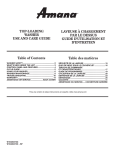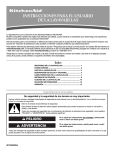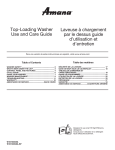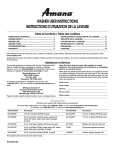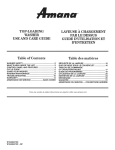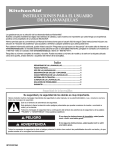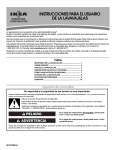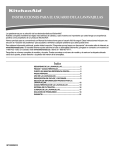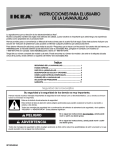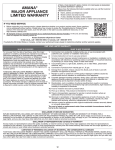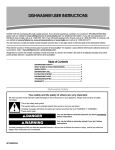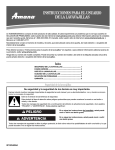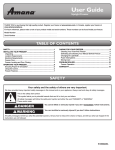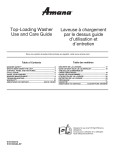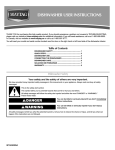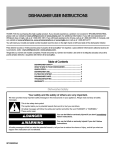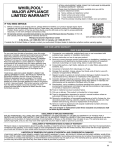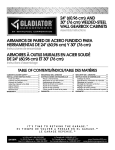Download Amana ADB1400PYS Owner's Manual
Transcript
DISHWASHER USER INSTRUCTIONS THANK YOU for purchasing this high-quality product. If you should experience a problem not covered in TROUBLESHOOTING, please visit our website at www.whirlpool.com, www.amana.com or www.ikea.com for additional information. If you still need assistance for Whirlpool, Ikea or Inglis, call us at 1-800-253-1301. If you still need assistance for Amana, call us at 1-800-843-0304. In Canada, visit our website at www.whirlpool.ca, www.amanacanada.ca, www.ikea.ca or www.inglis.ca or call us at 1-800-807-6777. You will need your model and serial number located near the door on the right-hand or left-hand side of the dishwasher interior. Para obtener acceso a “Instrucciones para el usuario de la lavavajillas” en español, o para obtener información adicional acerca de su producto, visite : www.whirlpool.com, www.amana.com o www.ikea.com. Tenga listo su número de modelo completo. Puede encontrar su número de modelo y de serie en la etiqueta ubicada cerca de la puerta al lado derecho o izquierdo del interior de la lavavajillas. Table of Contents DISHWASHER SAFETY ............................................................. 1 WHAT’S NEW IN YOUR DISHWASHER ................................... 3 QUICK STEPS............................................................................. 4 DISHWASHER USE .................................................................... 5 FILTRATION SYSTEM................................................................ 7 DISHWASHER CARE ................................................................. 8 TROUBLESHOOTING ................................................................ 9 WARRANTY .............................................................................. 10 Dishwasher Safety Your safety and the safety of others are very important. We have provided many important safety messages in this manual and on your appliance. Always read and obey all safety messages. This is the safety alert symbol. This symbol alerts you to potential hazards that can kill or hurt you and others. All safety messages will follow the safety alert symbol and either the word “DANGER” or “WARNING.” These words mean: DANGER WARNING You can be killed or seriously injured if you don't immediately follow instructions. You can be killed or seriously injured if you don't follow instructions. All safety messages will tell you what the potential hazard is, tell you how to reduce the chance of injury, and tell you what can happen if the instructions are not followed. W10596250A IMPORTANT SAFETY INSTRUCTIONS WARNING: When using the dishwasher, follow basic precautions, including the following: ■ ■ ■ ■ ■ ■ ■ Read all instructions before using the dishwasher. Use the dishwasher only for its intended function. Use only detergents or rinse agents recommended for use in a dishwasher, and keep them out of the reach of children. When loading items to be washed: 1) Locate sharp items so that they are not likely to damage the door seal; and 2) Load sharp knives with the handles up to reduce the risk of cut-type injuries. Do not wash plastic items unless they are marked “dishwasher safe” or the equivalent. For plastic items not so marked, check the manufacturer's recommendations. Do not touch the heating element during or immediately after use. Do not operate the dishwasher unless all enclosure panels are properly in place. ■ ■ ■ ■ ■ Do not tamper with controls. Do not abuse, sit on, or stand on the door, lid, or dish racks of the dishwasher. To reduce the risk of injury, do not allow children to play in or on the dishwasher. Under certain conditions, hydrogen gas may be produced in a hot water system that has not been used for two weeks or more. HYDROGEN GAS IS EXPLOSIVE. If the hot water system has not been used for such a period, before using the dishwasher turn on all hot water faucets and let the water flow from each for several minutes. This will release any accumulated hydrogen gas. As the gas is flammable, do not smoke or use an open flame during this time. Remove the door or lid to the washing compartment when removing an old dishwasher from service or discarding it. SAVE THESE INSTRUCTIONS GROUNDING INSTRUCTIONS ■ For a grounded, cord-connected dishwasher: The dishwasher must be grounded. In the event of a malfunction or breakdown, grounding will reduce the risk of electric shock by providing a path of least resistance for electric current. The dishwasher is equipped with a cord having an equipment-grounding conductor and a grounding plug. The plug must be plugged into an appropriate outlet that is installed and grounded in accordance with all local codes and ordinances. WARNING: Improper connection of the equipmentgrounding conductor can result in a risk of electric shock. ■ Check with a qualified electrician or service representative if you are in doubt whether the dishwasher is properly grounded. Do not modify the plug provided with the dishwasher; if it will not fit the outlet, have a proper outlet installed by a qualified electrician. For a permanently connected dishwasher: The dishwasher must be connected to a grounded metal, permanent wiring system, or an equipment-grounding conductor must be run with the circuit conductors and connected to the equipment-grounding terminal or lead on the dishwasher. SAVE THESE INSTRUCTIONS WARNING Tip Over Hazard Do not use dishwasher until completely installed. Do not push down on open door. Doing so can result in serious injury or cuts. State of California Proposition 65 Warnings: WARNING: This product contains one or more chemicals known to the State of California to cause cancer. WARNING: This product contains one or more chemicals known to the State of California to cause birth defects or other reproductive harm. 2 What’s New in Your Dishwasher Energy Congratulations on purchasing your water and energy efficient dishwasher! This dishwasher cleans by spraying the dishes with water and pauses to allow the detergent to soak into and release the soils on the dishes. The cycles are longer due to the soak and pauses for exceptional cleaning. Several models contain an optical water sensor. The optical water sensor is used to determine the optimum water and energy consumption for great cleaning performance. Efficient dishwashers run longer to save water and energy, just as driving a car slower saves on gas. The first cycle using the sensor will run longer to calibrate the optical sensor. Performance Rinse Aid Using rinse aid will optimize your drying and wash performance. This dishwasher is specifically designed to be used with rinse aid for improved drying performance and controlling buildup of hard water deposits. Energy efficient dishwashers use less water and energy, so they depend on the water “sheeting” action of rinse aid for total optimal performance. Detergent The United States has passed a restriction limiting the amount of phosphorus (phosphates) in the household dishwasher detergents to no more than 0.5%, where previous detergents contained 8.7%. Major manufacturers have reformulated their dishwasher detergent for this change in detergents as another step in eco-conscious awareness. With these recent changes it is recommended to use tablets and packs for convenience and improved performance. Filtration System Your dishwasher has the latest technology in dishwasher filtration. This triple filtration system minimizes sound and optimizes water and energy conservation while providing optimal cleaning performance. Maintenance of your filters regularly will sustain peak cleaning performance. We suggest you clean both your upper and lower filter and rinse under running water at least once a month. L O C PU K SH DOWN & T UR N L UN O CK 3 Quick Steps 1 Prepare and load dishwasher. 4 Start dishwasher. 5 Unload and clean the filter. Spin the spray arms. They should turn freely. 2 Add detergent and rinse aid. For models with controls on top of the door, select wash cycle, option and press START/ RESUME before closing the door. Push door firmly closed. The door latches automatically. For models with front controls, select the wash cycle, options and press START/ RESUME or press START/RESUME to repeat the same cycle and options as in the previous wash cycle. PUSH DOWN & TU RN LO C See “Recommended Time Interval to Clean Your Filter,” in the “Filtration System” section for the recommended cleaning schedule. K K UNLOC 3 4 Select a cycle and option (cycles and options vary by model). Dishwasher Use STEP 1 STEP 2 Prepare and Load the Dishwasher Add Detergent IMPORTANT: Remove leftover food, bones, toothpicks and other hard items from the dishes. Remove labels from containers before washing. NOTE: If you do not plan to run a wash cycle soon, run a rinse cycle. Do not use detergent. ■ Use automatic dishwasher detergent only. Add powder, liquid or tablet detergent just before starting a cycle. 10 Place load pattern (when silverware basket is in lower rack) ■ ■ Upper rack ■ For optimum performance, tablet detergent is recommended. Lower rack 12 Place load pattern (when silverware basket is on the door) Upper rack Fresh automatic dishwasher detergent results in better cleaning. Store tightly closed detergent container in a cool, dry place. Lower rack Make sure nothing keeps spray arm(s) from spinning freely. It is important for the water spray to reach all soiled surfaces. A Hard Water Hard Water Soft Water Soft Water B MAIN WASH C PREWASH A. Cover latch B. Main Wash section C. Pre-Wash section The amount of detergent to use depends on: How much soil remains on the items - Heavily soiled loads require more detergent. The hardness of the water - If you use too little in hard water, dishes won't be clean. If you use too much in soft water, glassware will etch. Soft to Medium Water (0-6 grains per U.S. gallon) [typical water softener water and some city water] Medium to Hard Water (7-12 grains per U.S. gallon) [well water and some city water] ■ Depending on your water hardness, fill the Main Wash section of the dispenser as shown. Fill the Pre-Wash section to the level shown, if needed. NOTE: Fill amounts shown Hard Water are for standard powdered Hard Water Soft Water Soft Water detergent. Follow instructions on the package when using Main Wash Pre-Wash other dishwasher detergent. ■ Add Rinse Aid Items should be loaded with soiled surfaces facing down and inward to the spray as shown. This will improve cleaning and drying results. ■ Avoid overlapping items like bowls or plates that may trap food. ■ Place plastics, small plates and glasses in the upper rack. Wash only plastic items marked “dishwasher safe.” ■ To avoid thumping/clattering noises during operation: Load dishes so they do not touch one another. Make sure lightweight load items are secured in the racks. ■ When loading silverware, always place sharp items pointing down. Mix other items pointing up and some pointing down. Your dishwasher is designed to use rinse aid for good drying performance. Without rinse aid your dishes and dishwasher interior will have excessive moisture. The heat dry option will not perform as well without rinse aid. ■ Rinse aid keeps water from forming droplets that can dry as spots or streaks. They also improve drying by allowing water to drain off of the dishes after the final rinse. ■ Rinse aid helps to reduce excess moisture on the dish racks and interior of your dishwasher. ■ Check the rinse aid indicator. Add rinse aid when indicator drops to “Refill” level. ■ To add rinse aid, turn the dispenser cap to “Open” and lift off. Pour rinse aid into the opening until the indicator level is at “Full.” Replace the dispenser cap and turn to “Lock.” Make sure cap is fully locked. Full Add Lock -- - 654 3 ll fi 2 1 - Refill - - - - ■ ■ ax Make sure that when the dishwasher door is closed no items are blocking the detergent dispenser. m ■ - - - - - ¹⁄₄ turn to lock 5 ll m ax fi -- - - - - - NOTE: For most water conditions, the factory setting will give good results. If you have hard water or notice rings or spots, try a higher setting. Turn the arrow adjuster inside the dispenser by either using your fingers or inserting a flat-blade screwdriver into the center of the arrow and turning. -- - - - Sani Rinse – (can be selected with Heavy and Normal wash cycles) Select this option to raise the water temperature in the final rinse to approximately 155°F (68°C). Sani Rinse option adds heat and time to the cycle. This high temperature rinse sanitizes your dishes and glassware in accordance with NSF/ANSI Standard 184 for Residential Dishwashers. Certified residential dishwashers are not intended for licensed food establishments. Heat Dry – (can be selected with 1-HR Wash, Heavy and Normal wash cycles) When selected with the 1-Hr Wash cycle, the time is increased by approximately 30 minutes. STEP 3 4-HR Delay – (any cycle) offers the choice to start the dishwasher Select a Cycle (cycles vary by model) automatically at a later time. Select a wash cycle and options. Press 4-HR Delay. Press START/RESUME. Close the door firmly. Press the Select Cycles button until the light below the desired cycle is on. NOTE: Heavier cycles and options affect cycle length. Some cycles and options will take up to 3¹⁄₂ hours to complete. Lock – (on 4-HR Delay button) use to avoid unintended use of your dishwasher. When Control Lock is lit, all buttons are disabled. The dishwasher door can be opened while the controls are locked. Heavy – Use for heavily soiled, hard-to-clean items. Normal – This cycle is recommended to completely wash a full load of normally soiled dishes. Selecting this cycle will default to the options recommended for normal amounts of food soil. The energy label is based on this cycle. ECO – Use for lightly soiled items. It saves energy. 1-HR Wash – Use for lightly soiled items. For fast results, 1-Hr To turn on Lock: Press and hold 4-HR Delay for at least 3 seconds. The Locked light glows. If you press any pad while your dishwasher is locked, the light flashes 3 times. To turn off Lock: Press and hold 4-HR Delay for at least 3 seconds. The Control Lock light turns off. STEP 4 Start or Resume a Cycle ■ Run hot water at the sink nearest your dishwasher until the water is hot. Turn off water. ■ Push door firmly closed. The door latches automatically. Select the wash cycle and options desired OR press START/RESUME to repeat the same cycle and options as in the previous wash cycle. For top controls, select cycle and options first, and then close the door. ■ You can add an item anytime before the main wash starts. Open the door slowly and add the item. Close the door firmly. Press START/ RESUME. ■ The Clean indicator glows when the cycle is finished. Sanitized glows when Sani Rinse option is selected and sanitization levels occur. Wash will clean the dishes using slightly more water and energy. Overnight cycle – Use for loads with heavy amounts of food soil. It is a longer cycle and therefore is ideal to run overnight. Rinse Only – (no options apply to this cycle) Do not use detergent. This is only a rinse that keeps food from drying on your dishes and reduces odor buildup in your dishwasher until you are ready to wash a full load. Select Options (options vary by model) You can customize your cycles by pressing the options desired. Repeatedly press the button until the desired combination of options is selected. High Temp – (can be selected with Heavy and Normal wash cycles) heats the water during the wash portions of the cycle. 6 Filtration System Your dishwasher has the latest technology in dishwasher filtration. This triple filtration system minimizes sound and optimizes water and energy conservation while providing superior cleaning performance. Throughout the life of your dishwasher, the filter will require maintenance to sustain peak cleaning performance. The triple filter system consists of 2 parts, an upper filter assembly and a lower filter. ■ The upper filter assembly keeps oversized items and foreign objects, along with very fine food particles, out of the pump. The lower filter keeps food from being recirculated onto your dishware. The filters may need to be cleaned when: ■ Visible objects or soils are on the Upper Filter Assembly. ■ ■ There is degradation in cleaning performance (that is, soils still present on dishes). Dishes feel gritty to the touch. It is very easy to remove and maintain the filters. The chart below shows the recommended cleaning frequency. ■ RECOMMENDED TIME INTERVAL TO CLEAN YOUR FILTER Number of Loads Per Week If you only scrape before loading* If you scrape and rinse before loading If you wash before loading 8-12 Every two months Every four months Once per year 4-7 Every four months Once per year Once per year 1-3 Twice per year Once per year Once per year *Manufacturer's recommendation: This practice will conserve the water and energy that you would have used to prepare your dishes. This will also save you time and effort. Very Hard Water Cleaning Instructions If you have hard water (above 15 grains), clean your filter at least once per month. Building up of white residue on your dishwasher indicates hard water. For tips on removing spots and stains, see “Troubleshooting” section. IMPORTANT: Do not use wire brush, scouring pad, etc. as they may damage the filters. Rinse filter under running water until most soils are removed. If you have hard-to-remove soils or calcium deposits from hard water, a soft brush may be required. Filter Removal Instructions PUSH DOWN & TU RN LO L O K C C PU K SH DOWN & T UR N 1. Turn the Upper Filter Assembly ¼ turn counterclockwise and lift out. 2. Separate the upper filter assembly by gently pulling apart. 3. Clean the filters as shown. K UNLOC L UN O CK To remove Upper Filter Assembly 7 Filter Reinstallation Instructions 3. Slowly rotate the filter clockwise until it drops into place. Continue to rotate until the filter is locked into place. If the filter is not fully seated (still turns freely), continue to turn the filter clockwise until it drops and locks into place. NOTE: The Upper Filter Assembly arrow does not have to align with the arrow in the Lower Filter as long as the filter is locked. 1. Noting the previous illustrations, place the Lower Filter under the Locating Tabs in the bottom of the dishwasher so the round opening for the Upper Filter Assembly lines up with the round opening in the bottom of the tub. 2. Insert the Upper Filter Assembly into the circular opening in the Lower Filter. IMPORTANT: To avoid damage to dishwasher, do not operate your dishwasher without the filters properly installed. Be sure the Lower Filter is securely in place and the Upper Filter Assembly is locked into place. If the Upper Filter Assembly turns freely, it is not locked into place. PUS HD OW LO K C N & TUR N U NL OCK To replace Upper Filter Assembly Dishwasher Care CLEANING THE DISHWASHER Cleaning the exterior Clean the exterior of the dishwasher with a soft, damp cloth and mild detergent. If your dishwasher has a stainless steel exterior, a stainless steel cleaner is recommended - Stainless Steel Cleaner and Polish Part Number 31464. Cleaning the interior Clean the interior of the dishwasher, with a paste of powdered dishwasher detergent and water or use liquid dishwasher detergent on a damp sponge to clean the cooled-down interior. A white vinegar rinse may remove white spots and film. Vinegar is an acid, and using it too often could damage your dishwasher. Put 2 cups (500 mL) white vinegar in a glass or dishwasher-safe measuring cup on the bottom rack. Run the dishwasher through a complete washing cycle using an air-dry or an energy-saving dry option. Do not use detergent. Vinegar will mix with the wash water. Dishwasher Maintenance Procedure To help avoid odor or odor-causing residue in your dishwasher, use affresh®† dishwasher and disposer cleaner (recommended) once a month as part of routine maintenance. affresh® dishwasher and disposer cleaner is effective in all dishwasher brands. IMPORTANT: ■ Read these instructions and the instructions found on the affresh® product package completely before beginning the cleaning process. ■ Use foil wrapper or gloves when handling the tablet. †® affresh is a registered trademark of Whirlpool, U.S.A. 8 1. Remove all dishware from the dishwasher. Open the dishwasher and place 1 affresh® dishwasher and disposer tablet in the main detergent tray and close the tray. Place another tablet in the prewash tray or simply place 1 tablet in the bottom of the dishwasher. Close the dishwasher. Run the dishwasher on the most aggressive cycle - heavy duty scrub, heated water, etc. 2. Place 1 affresh® dishwasher and disposal tablet into the garbage disposal. Turn on hot water to slow flow. Run the disposal and water for 15 seconds. Turn off disposal and water. Do not flush disposal completely with water. Water from the dishwasher will clean out the disposal. If no garbage disposal, skip this step. Drain air gap If you have a drain air gap, check and clean it if the dishwasher isn't draining well. To Reduce Risk of Property Damage During Vacation or Extended Time Without Use ■ When you will not be using the dishwasher during the summer months, turn off the water and power supply to the dishwasher. ■ Make sure the water supply lines are protected against freezing conditions. Ice formations in the supply lines can increase water pressure and cause damage to your dishwasher or home. Damage from freezing is not covered by the warranty. ■ When storing your dishwasher in the winter, avoid water damage by having your dishwasher winterized by authorized service personnel. Troubleshooting First try the solutions suggested here or visit our website and reference FAQs (Frequently Asked Questions) to possibly avoid the cost of a service call. In the U.S.A., www.whirlpool.com In Canada, www.whirlpool.ca In the U.S.A., www.amana.com In Canada, www.amanacanada.ca In the U.S.A., www.ikea.com In Canada, www.ikea.ca In U.S.A., www.whirlpool.com In Canada, www.inglis.ca Dishwasher is not operating properly ■ ■ ■ ■ Dishwasher does not run or stops during a cycle Is the door closed tightly and latched? Is the right cycle selected? Is there power to the dishwasher? Has a household fuse blown, or has a circuit breaker tripped? Replace the fuse or reset the circuit breaker. If the problem continues, call an electrician. Has the motor stopped due to an overload? The motor automatically resets itself within a few minutes. If it does not restart, call for service. Is the water shutoff valve (if installed) turned on? It is normal for certain cycles to repeatedly pause for several seconds during the main wash. The Clean light is flashing Call for service. Dishwasher will not fill Is the overfill protection float able to move up and down freely? Press down to release. Dishwasher seems to run too long The dishwasher can run up to 3¹⁄₂ hours depending on soil level, water temperature, cycles and options. Is the water supplied to the dishwasher hot enough? The dishwasher runs longer while heating water. Is the dishwasher cycle time within the cycle times? See cycle sections wash times. A delay automatically occurs in some wash and rinse cycles until the water reaches the proper temperature. This dishwasher is equipped with an optical sensor wash that detects water temperature, soil and detergent amount. Wash cycles are adjusted based on what is sensed. IMPORTANT: The very first wash cycle after installation in your home will be adjusted to include an additional 2 rinses. This cycle must not be interrupted for proper sensor adjustment. If this adjustment cycle is canceled or stopped before the Clean light comes on at the end of the cycle, the next wash cycle will repeat this sensor adjustment. ■ Water remains in the dishwasher Is the cycle complete? ■ Detergent remains in the covered section of the dispenser Is the cycle complete? Is the detergent lump-free? Replace detergent if necessary. Is the dispenser door blocked by dishes or cookware when the dishwasher door is closed? White residue on the front of the access panel Was too much detergent used? Is the brand of detergent making excess foam? Try a different brand to reduce foaming and eliminate buildup. ■ ■ ■ Odor in the dishwasher Are dishes washed only every 2 or 3 days? Run a rinse cycle once or twice a day until you have a full load. Does the dishwasher have a new plastic smell? Run a vinegar rinse as described in “Dishwasher Care.” Condensation on the kitchen counter (built-in models) Is the dishwasher aligned with the countertop? Moisture from the vent in the dishwasher console can form on the counter. Refer to the Installation Instructions for more information. Dishes do not dry completely ■ Dishes do not dry completely Did you use a rinse aid? Your dishwasher is designed to use rinse aid for good drying performance. Without rinse aid your dishes and dishwasher interior will have excessive moisture. The heat dry option will not perform as well without rinse aid. ■ Dishes are not dry Did you load your dishwasher to allow proper water drainage? Do not overload. Use a liquid rinse aid to speed drying. Are the plastics wet? Plastics often need towel drying. Is the rinse aid dispenser empty? Did you use an air-dry or energy-saving dry option? Use a heated drying option for dryer dishes. Excess moisture on racks and dishwasher interior Check the rinse aid indicator to see that there is rinse aid in the dispenser. ■ Spots and stains on dishes ■ Spotting and filming on dishes Is your water hard, or is there a high mineral content in your water? Conditioning the final rinse water with a liquid rinse aid helps eliminate spotting and filming. Keep the rinse aid dispenser filled. Always use a high-temp option. If your water hardness is 13 grains or above, it is strongly recommended that you install a home water softener. If you do not wish to drink softened water, have the softener installed onto your hot water supply. Is the water temperature too low? For best dishwashing results, water should be 120°F (49°C) as it enters the dishwasher. Did you use the correct amount of effective detergent? Use recommended dishwasher detergents only. Do not use less than 1 tbs (15 g) per load. Detergent must be fresh to be effective. Heavy soil and/or hard water generally require extra detergent. Is the home water pressure high enough for proper dishwasher filling? Home water pressure should be 20 to 120 psi (138 to 828 kPa) for proper dishwasher fill. If you have questions about your water pressure, call a licensed, qualified plumber. NOTE: To remove spots and film from glassware, remove all silverware and metal items and see the “Dishwasher Maintenance Procedure” in the “Dishwasher Care” section. 9 ■ ■ ■ ■ ■ Silica film or etching (silica film is a milky, rainbow-colored deposit; etching is a cloudy film) Sometimes there is a water/chemical reaction with certain types of glassware. This is usually caused by some combination of soft or softened water, alkaline washing solutions, insufficient rinsing, overloading the dishwasher, and the heat of drying. It might not be possible to avoid the problem, except by hand washing. To slow this process use a minimum amount of detergent but not less than 1 tbs (15 g) per load. Use a liquid rinse aid and underload the dishwasher to allow thorough rinsing. Silica film and etching are permanent and cannot be removed. Do not use heated drying. ■ White spots on cookware with nonstick finish Has the dishwasher detergent removed cookware seasoning? Reseason cookware after washing it in the dishwasher. Brown stains on dishes and dishwasher interior Does your water have high iron content? Rewash dishes using 1-3 tsp (5-15 mL) of citric acid crystals added to the covered section of the detergent dispenser. Do not use detergent. Follow with a Normal wash cycle with detergent. If treatment is needed more often than every other month, the installation of an iron removal unit is suggested. Black or gray marks on dishes Are aluminum items rubbing dishes during washing? Disposable aluminum items can break down in the dishwasher and cause marking. Hand wash these items. Remove aluminum markings by using a mild abrasive cleaner. Orange stains on plastic dishes or dishwasher interior Are large amounts of tomato-based foods on dishes placed in the dishwasher? It may be necessary to use a stain removal product to remove stains from your dishwasher. Stains will not affect dishwasher performance. Noises ■ Dishes are not completely clean Grinding, grating, crunching or buzzing sounds A hard object has entered the wash module (on some models). When the object is ground up, the sound should stop. If the noise persists after a complete cycle, call for service. Food soil left on the dishes Is the dishwasher loaded correctly? Did you choose the cycle that describes the most difficult soil in your dishwasher? If you have some items with heavier soils, use a heavier cycle. Is the water temperature too low? For best dishwashing results, water should be 120°F (49°C) as it enters the dishwasher. Did you use the correct amount of fresh detergent? Use recommended dishwasher detergents only. Do not use less than 1 tbs (15 g) per load. Detergent must be fresh to be effective. Heavy soil and/or hard water generally require extra detergent. Is detergent caked in dispenser? Use fresh detergent only. Do not allow detergent to sit for several hours in a wet dispenser. Clean dispenser when caked detergent is present. Is the pump or spray arm clogged by labels from bottles and cans? Is the home water pressure high enough for proper dishwasher filling? Home water pressure should be 20 to 120 psi (138 to 828 kPa) for proper dishwasher fill. If you have questions about your water pressure, call a licensed, qualified plumber. Are high suds slowing the wash arm? Do not use soap or laundry detergents. Use recommended dishwasher detergents only. Dishes are damaged during a cycle ■ Chipping of dishes Did you load the dishwasher properly? Load the dishes and glasses so they are stable and do not strike together from washing action. Minimize chipping by moving the rack in and out slowly. NOTE: Antiques, feather-edged crystal, and similar types of china and glassware might be too delicate for automatic dishwashing. Wash by hand. WHIRLPOOL CORPORATION MAJOR APPLIANCE WARRANTY LIMITED WARRANTY For one year from the date of purchase, when this major appliance is operated and maintained according to instructions attached to or furnished with the product, Whirlpool Corporation or Whirlpool Canada LP (hereafter “Whirlpool”) will pay for Factory Specified Parts and repair labor to correct defects in materials or workmanship. Service must be provided by a Whirlpool designated service company. This limited warranty is valid only in the United States or Canada and applies only when the major appliance is used in the country in which it was purchased. Outside the 50 United States and Canada, this limited warranty does not apply. Proof of original purchase date is required to obtain service under this limited warranty. ITEMS EXCLUDED FROM WARRANTY This limited warranty does not cover: 1. Service calls to correct the installation of your major appliance, to instruct you on how to use your major appliance, to replace or repair house fuses, or to correct house wiring or plumbing. 2. Service calls to repair or replace appliance light bulbs, air filters or water filters. Consumable parts are excluded from warranty coverage. 3. Repairs when your major appliance is used for other than normal, single-family household use or when it is used in a manner that is contrary to published user or operator instructions and/or installation instructions. 4. Damage resulting from accident, alteration, misuse, abuse, fire, flood, acts of God, improper installation, installation not in accordance with electrical or plumbing codes, or use of consumables or cleaning products not approved by Whirlpool. 5. Cosmetic damage, including scratches, dents, chips or other damage to the finish of your major appliance, unless such damage results from defects in materials or workmanship and is reported to Whirlpool within 30 days from the date of purchase. 6. Any food loss due to refrigerator or freezer product failures. 7. Costs associated with the removal from your home of your major appliance for repairs. This major appliance is designed to be repaired in the home and only in-home service is covered by this warranty. 8. Repairs to parts or systems resulting from unauthorized modifications made to the appliance. 10 9. Expenses for travel and transportation for product service if your major appliance is located in a remote area where service by an authorized Whirlpool servicer is not available. 10. The removal and reinstallation of your major appliance if it is installed in an inaccessible location or is not installed in accordance with published installation instructions. 11. Major appliances with original model/serial numbers that have been removed, altered or cannot be easily determined. This warranty is void if the factory applied serial number has been altered or removed from your major appliance. The cost of repair or replacement under these excluded circumstances shall be borne by the customer. DISCLAIMER OF IMPLIED WARRANTIES; LIMITATION OF REMEDIES CUSTOMER'S SOLE AND EXCLUSIVE REMEDY UNDER THIS LIMITED WARRANTY SHALL BE PRODUCT REPAIR AS PROVIDED HEREIN. IMPLIED WARRANTIES, INCLUDING WARRANTIES OF MERCHANTABILITY OR FITNESS FOR A PARTICULAR PURPOSE, ARE LIMITED TO ONE YEAR OR THE SHORTEST PERIOD ALLOWED BY LAW. WHIRLPOOL SHALL NOT BE LIABLE FOR INCIDENTAL OR CONSEQUENTIAL DAMAGES. SOME STATES AND PROVINCES DO NOT ALLOW THE EXCLUSION OR LIMITATION OF INCIDENTAL OR CONSEQUENTIAL DAMAGES, OR LIMITATIONS ON THE DURATION OF IMPLIED WARRANTIES OF MERCHANTABILITY OR FITNESS, SO THESE EXCLUSIONS OR LIMITATIONS MAY NOT APPLY TO YOU. THIS WARRANTY GIVES YOU SPECIFIC LEGAL RIGHTS, AND YOU MAY ALSO HAVE OTHER RIGHTS WHICH VARY FROM STATE TO STATE OR PROVINCE TO PROVINCE. If outside the 50 United States and Canada, contact your authorized Whirlpool dealer to determine if another warranty applies. 6/12 For additional product information or to view FAQs (Frequently Asked Questions), in U.S.A., visit www.whirlpool.com, www.amana.com or www.ikea.com. In Canada, visit www.whirlpool.ca, www.amanacanada.ca, www.ikea.ca or www.inglis.ca. If you do not have access to the Internet and you need assistance using your product or you would like to schedule service, you may contact Whirlpool at the number below. Have your complete model number ready. You can find your model number and serial number on the label located near the door on the right-hand or left-hand side of the dishwasher interior. For Whirlpool, Ikea and Inglis assistance or service in the U.S.A., call 1-800-253-1301. In Canada, call 1-800-807-6777. For Amana assistance or service in the U.S.A., call 1-800-843-0304. In Canada, call 1-800-807-6777. If you need further assistance, you can write to Whirlpool with any questions or concerns at the address below: In the U.S.A.: Whirlpool Brand Home Appliances Customer eXperience Center 553 Benson Road Benton Harbor, MI 49022-2692 Please include a daytime phone number in your correspondence. In Canada: Whirlpool Brand Home Appliances Customer eXperience Centre 200 – 6750 Century Ave. Mississauga ON L5N 0B7 Please keep these User Instructions and model number information for future reference. W10596250A © 2013. All rights reserved. 5/13 Printed in U.S.A. 11 INSTRUCCIONES PARA EL USUARIO DE LA LAVAVAJILLAS LE AGRADECEMOS la compra de este producto de alta calidad. Si usted experimenta un problema que no se haya cubierto en SOLUCIÓN DE PROBLEMAS, visite nuestro sitio de internet en www.whirlpool.com, www.amana.com o www.ikea.com para obtener información adicional. Si considera que aún necesita ayuda para Whirlpool, Ikea o Inglis, llámenos al 1-800-253-1301. Si considera que aún necesita ayuda para Amana, llámenos al 1-800-843-0304. En Canadá, visite nuestro sitio de internet en www.whirlpool.ca, www.amanacanada.ca, www.ikea.ca o www.inglis.ca o llámenos al 1-800-807-6777. Necesitará tener a mano el número de modelo y de serie, que está ubicado cerca de la puerta del lado derecho o izquierdo del interior de la lavavajillas. Índice SEGURIDAD DE LA LAVAVAJILLAS ...................................... 12 QUÉ HAY DE NUEVO EN SU LAVAVAJILLAS....................... 14 PASOS RÁPIDOS ..................................................................... 15 USO DE LA LAVAVAJILLAS .................................................... 16 SISTEMA DE FILTRACIÓN...................................................... 18 CUIDADO DE LA LAVAVAJILLAS........................................... 19 SOLUCIÓN DE PROBLEMAS ................................................. 20 GARANTÍA ................................................................................ 22 Seguridad de la lavavajillas Su seguridad y la seguridad de los demás es muy importante. Hemos incluido muchos mensajes importantes de seguridad en este manual y en su electrodoméstico. Lea y obedezca siempre todos los mensajes de seguridad. Este es el símbolo de advertencia de seguridad. Este símbolo le llama la atención sobre peligros potenciales que pueden ocasionar la muerte o una lesión a usted y a los demás. Todos los mensajes de seguridad irán a continuación del símbolo de advertencia de seguridad y de la palabra “PELIGRO” o “ADVERTENCIA”. Estas palabras significan: PELIGRO Si no sigue las instrucciones de inmediato, usted puede morir o sufrir una lesión grave. ADVERTENCIA Si no sigue las instrucciones, usted puede morir o sufrir una lesión grave. Todos los mensajes de seguridad le dirán el peligro potencial, le dirán cómo reducir las posibilidades de sufrir una lesión y lo que puede suceder si no se siguen las instrucciones. 12 INSTRUCCIONES IMPORTANTES DE SEGURIDAD ADVERTENCIA: Cuando use la lavavajillas siga precauciones básicas, incluyendo las siguientes: ■ Lea todas las instrucciones antes de usar la lavavajillas. ■ Use la lavavajillas únicamente para las funciones que fue diseñada. Use únicamente detergentes o agentes de enjuague recomendados para ser usados en las lavavajillas y manténgalos fuera del alcance de los niños. Al introducir los artículos para lavar: 1) Coloque los artículos puntiagudos de manera que no dañen el sello de la puerta 2) Introduzca los cuchillos filosos con los mangos hacia arriba para reducir el riesgo de cortaduras. No lave artículos de plástico que no lleven la indicación “lavables en la lavavajillas” u otra similar. Lea las recomendaciones del fabricante para los artículos de plástico que no lleven tal indicación. No toque el elemento de calefacción durante o inmediatamente después de usar la lavavajillas. ■ ■ ■ ■ No haga funcionar la lavavajillas a menos que todos los paneles estén colocados debidamente en su lugar. No juegue con los controles. No abuse, ni se siente ni se pare sobre la puerta, la tapa o sobre las canastas de la lavavajillas. Para reducir el riesgo de lesión, no permita que los niños jueguen dentro ni sobre la lavavajillas. Bajo ciertas condiciones, un sistema de agua caliente que no ha sido usado por dos semanas o más puede producir gas hidrógeno. EL GAS HIDRÓGENO ES EXPLOSIVO. Si el sistema de agua caliente no ha sido usado por ese período, abra todas las llaves de agua caliente y deje que corra el agua por varios minutos antes de usar la lavavajillas. Esto permitirá que los gases acumulados escapen. Debido a que el gas es inflamable, no fume ni encienda ninguna llama abierta durante este tiempo. Quite la puerta o la tapa del compartimiento de lavado cuando remueva o deje de usar para siempre una vieja lavavajillas. ■ ■ ■ ■ ■ ■ GUARDE ESTAS INSTRUCCIONES INSTRUCCIONES DE CONEXIÓN A TIERRA ■ Para una lavavajillas con cable eléctrico y conexión a tierra: La lavavajillas debe estar conectada a tierra. En caso de funcionamiento defectuoso o avería, la conexión a tierra reduce el riesgo de choque eléctrico al establecer una ruta de menor resistencia para la corriente eléctrica. La lavavajillas viene equipada con un cable eléctrico que tiene un conductor para conexión a tierra y un enchufe con conexión a tierra. El enchufe debe ser conectado a un contacto apropiado que esté instalado y conectado a tierra de acuerdo con todos los códigos y ordenanzas locales. ADVERTENCIA: La conexión inadecuada del conductor de conexión a tierra puede resultar en riesgo ■ de choque eléctrico. Pregunte a un electricista calificado o a un agente de servicio si no está seguro si la lavavajillas está adecuadamente conectada a tierra. No modifique el enchufe que viene con la lavavajillas. Si no cabe en el contacto, pida que un electricista calificado instale un contacto apropiado. Para lavavajillas con conexión permanente: Esta lavavajillas debe estar conectada a un sistema de cableado de metal permanente, conectado a tierra, o se debe tender un conducto para la conexión a tierra del equipo con los conductores de circuito y conectado a la terminal de tierra del equipo o al conductor de suministro de la lavavajillas. GUARDE ESTAS INSTRUCCIONES ADVERTENCIA Peligro de Vuelco No use la lavavajillas antes de estar completamente instalada. No se apoye en la puerta abierta. No seguir estas instrucciones puede ocasionar heridas serias o cortaduras. Advertencias de la Proposición 65 del estado de California: ADVERTENCIA: Este producto contiene una o más sustancias químicas identificadas por el estado de California como causantes de cáncer. ADVERTENCIA: Este producto contiene una o más sustancias químicas identificadas por el estado de California como causantes de defectos congénitos o algún otro tipo de daños en la función reproductora. 13 Qué hay de nuevo en su lavavajillas Energía ¡Felicitaciones por haber comprado la lavavajillas con bajo consumo de agua y energía! Esta lavavajillas limpia rociando la vajilla con agua y hace pausas para permitir que el detergente remoje la vajilla y afloje la suciedad de los platos. Para obtener una limpieza excepcional, los ciclos se hacen más largos debido al remojo y las pausas. Varios modelos tienen un sensor óptico de agua. El sensor óptico de agua se usa para determinar el consumo óptimo de agua y energía para un desempeño de limpieza ideal. Las lavavajillas eficaces funcionan por más tiempo para ahorrar agua y energía, de la misma manera que se ahorra gasolina cuando se conduce un automóvil más despacio. El primer ciclo con sensor durará más tiempo para calibrar el sensor óptico. Desempeño Agente de enjuague El uso del agente de enjuague hará óptimo el desempeño de lavado y secado. Esta lavavajillas ha sido diseñada específicamente para usarse en conjunción con agente de enjuague, para obtener un mejor desempeño de secado y controlar la acumulación de depósitos de agua dura. Las lavavajillas con bajo consumo de energía usan menos agua y energía, de modo que dependen de la acción de desplazamiento del agua por obra del agente de enjuague para asegurar un óptimo desempeño. Detergente Estados Unidos ha aprobado una restricción que limita la cantidad de fósforo (fosfatos) en los detergentes para lavavajillas domésticas a no más de 0,5 %, mientras que los detergentes previos contenían 8,7 %. Los principales fabricantes han reformulado su detergente para lavavajillas de acuerdo a este cambio, un paso más en la conciencia ecológica. Con estos cambios recientes, se recomienda usar pastillas y paquetes por conveniencia y para mejorar el desempeño. Sistema de filtración Su lavavajillas cuenta con lo último en tecnología de filtración para lavavajillas. El sistema de filtración triple minimiza los sonidos y optimiza el ahorro de agua y energía mientras proporciona una limpieza óptima. El mantenimiento periódico de los filtros hará posible un rendimiento superior de limpieza. Le sugerimos limpiar el filtro superior e inferior y enjuagarlos bajo agua del grifo por lo menos una vez al mes. L O C PU K SH DOWN & T UR N L UN O CK 14 Pasos rápidos 1 Prepare y cargue la lavavajillas. 4 Para los modelos con controles en la parte superior de la puerta, seleccione el ciclo de lavado, la opción y presione START/RESUME (Inicio/ Reanudar) antes de cerrar la puerta. Empuje la puerta cerrándola con firmeza. La puerta queda asegurada automáticamente. Para modelos con controles delanteros, seleccione el ciclo y las opciones de lavado y presione START/RESUME (Inicio/Reanudar) o bien presione START/RESUME (Inicio/Reanudar) para repetir el mismo ciclo y opciones que en el ciclo anterior de lavado. Haga girar los brazos rociadores. Deben girar libremente. 2 Agregue el detergente y el agente de enjuague. Ponga la lavavajillas en marcha. 5 Saque el filtro y límpielo. Consulte “Intervalos recomendados para la limpieza del filtro” en la sección “Sistema de filtración” para ver el programa de limpieza recomendado. PUSH DOWN & TU RN LO C K K UNLOC 3 Seleccione un ciclo y una opción (los ciclos y las opciones varían según el modelo). 15 Uso de la lavavajillas PASO 1 PASO 2 Prepare y cargue la lavavajillas Agregue detergente IMPORTANTE: Quite los restos de alimentos, huesos, palillos y otros artículos duros de los platos. Quite las etiquetas de los recipientes antes de lavarlos. NOTA: Si no va a hacer funcionar un ciclo de lavado de inmediato, haga funcionar un ciclo de enjuague. No use detergente. ■ Use únicamente detergentes para lavavajillas automáticas. Agregue detergente en polvo, líquido o en pastilla justo antes de comenzar un ciclo. ■ El detergente para lavavajillas automáticas produce mejores resultados cuando está fresco. Guarde el detergente bien cerrado en un lugar fresco y seco. Modelo de carga para 10 puestos (cuando la canastilla de los cubiertos está en la canasta inferior) ■ Canasta superior Canasta inferior Modelo de carga para 12 puestos (cuando la canastilla de los cubiertos está en la puerta) Canasta superior Canasta inferior ■ Asegúrese de que nada impida que el(los) brazo(s) rociador(es) gire(n) libremente. Es importante que el rociado de agua alcance todas las superficies sucias. ■ Asegúrese de que cuando esté cerrada la puerta de la lavavajillas no haya artículos bloqueando el depósito de detergente. ■ Los artículos deberán cargarse con las superficies sucias mirando hacia abajo y hacia adentro, hacia el rociador, como se muestra. Esto mejorará los resultados de limpieza y de secado. ■ Evite superponer los artículos como tazones o platos, que puedan atrapar la comida. ■ Coloque los plásticos, platos pequeños y vasos en la canasta superior. Lave sólo artículos de plástico marcados como “lavable en la lavavajillas”. ■ Para evitar ruidos descomunales o estrepitosos durante el funcionamiento: Coloque los platos de manera que no se toquen entre sí. Asegúrese de que los objetos livianos estén firmes en las canastas. ■ Cuando cargue la canastilla de los cubiertos, coloque siempre los artículos filosos con las puntas hacia abajo. Mezcle otros artículos de modo que algunos estén hacia arriba y otros hacia abajo. 16 Para un rendimiento óptimo, se recomienda detergente en tableta. A Hard Water Soft Water Hard Water Soft Water B MAIN WASH PREWASH C A. Seguro de la tapa B. Sección de lavado principal C. Sección de prelavado La cantidad de detergente a usar depende de: Cuánta suciedad permanece en los artículos - Las cargas con suciedad profunda requieren más detergente. La dureza del agua - Si usa muy poco en agua dura, los platos no quedarán limpios. Si usa demasiado en agua blanda, las piezas de cristal quedarán manchadas. Agua suave a medio dura (0-6 granos por galón de EE.UU.) [agua típica tratada con ablandador de agua y cierto tipo de agua urbana] Agua medio dura a dura (7-12 granos por galón de EE.UU.) [agua de pozo y cierto tipo de agua urbana] ■ Según la dureza del agua, llene la sección de lavado principal del depósito, como se muestra. Llene la sección de prelavado hasta el nivel mostrado, si es necesario. NOTA: Los niveles de llenado Hard Water que se indican corresponden Hard Water Soft Water Soft Water a los detergentes en polvo estándares. Siga las Lavado principal Prelavado instrucciones del paquete cuando use otro detergente para lavavajillas. ■ Agregue el agente de enjuague ■ Para obtener un buen secado, su lavavajillas ha sido diseñada para usar agente de enjuague. Si no usa agente de enjuague, los platos y el interior de la lavavajillas tendrán demasiada humedad. La opción de secado con calor no funcionará tan bien sin usar el agente de enjuague. ■ Los agentes de enjuague evitan que el agua forme gotitas que pueden secarse como manchas o rayas. Asimismo mejoran el secado, pues permiten que el agua se escurra de los platos después del enjuague final. ■ El agente de enjuague ayuda a reducir el exceso de humedad sobre las canastas de los platos y el interior de la lavavajillas. ■ Revise el indicador del agente de enjuague. Agregue el agente de enjuague cuando el indicador baje hasta el nivel de “Refill” (Volver a llenar). Full Add Presione repetidamente el botón hasta que seleccione la combinación deseada de opciones. Lock -- - 2 1 Refill High Temp (Temperatura alta) - (Puede seleccionarse con los 654 3 ll fi - - - - - Para agregar agente de enjuague, gire la tapa del depósito hacia “Open” (Abrir) y quítela. Vierta el agente de enjuague en la abertura hasta que el indicador esté en “Full” (Lleno). Vuelva a colocar la tapa del depósito y gírela hacia “Lock” (Bloqueo). Cerciórese de que la tapa esté asegurada por completo. m ax ■ - - - - - ¹⁄₄ de giro para asegurar ll -- - m ax fi - - - - - NOTA: Para casi todos los tipos de agua, la selección de fábrica dará buenos resultados. Si tiene agua dura o nota que hay aros o manchas, pruebe con un ajuste más alto. Gire el regulador en forma de flecha que se encuentra dentro del depósito usando sus dedos o insertando un destornillador de hoja plana en el centro de la flecha y haciéndola girar. -- - - - PASO 3 Seleccione un ciclo (los ciclos varían según el modelo) Presione el botón Select Cycle (Seleccionar un ciclo) hasta que se ilumine la luz debajo del ciclo deseado. NOTA: Los ciclos y las opciones más intensos afectarán la duración del ciclo. Algunos ciclos y opciones demorarán hasta 3½ horas en completarse. Heavy (intenso) - Úselo para los artículos que estén muy sucios y sean difíciles de limpiar. Normal - Se recomienda este ciclo para lavar por completo una carga llena de vajilla con suciedad normal. Al seleccionar este ciclo, se fijarán por defecto las opciones recomendadas para cantidades normales de suciedad. La etiqueta de consumo de energía está basada en este ciclo. ECO - Use este ciclo para artículos con suciedad ligera. Ahorra ciclos de lavado Heavy [Intenso] y Normal) - calienta el agua durante las porciones de lavado del ciclo. Sani Rinse (Enjuague sanitario) - (Puede seleccionarse con los ciclos de lavado Heavy [Intenso] y Normal) Seleccione esta opción para aumentar la temperatura del agua en el enjuague final a aproximadamente 155°F (68°C). La opción Sani Rinse (Enjuague sanitario), hace que aumente la temperatura y el tiempo de duración del ciclo. Este enjuague con alta temperatura higieniza sus platos y su cristalería según el Estándar NSF/ANSI 184 para lavavajillas domésticas. Las lavavajillas domésticas certificadas no han sido diseñadas para los establecimientos con licencia para alimentos. Heat Dry (Secado con calor) - (Puede seleccionarse con los ciclos de lavado 1-HR Wash (Lavado de 1 hora), Heavy (Intenso) y Normal) - Cuando se selecciona con el ciclo 1-Hr Wash (Lavado de 1 hora), el tiempo se incrementa en 30 minutos aproximadamente. 4-HR Delay (Retraso de 4 horas) - (Cualquier ciclo) Le ofrece la posibilidad de que la lavavajillas comience a funcionar más tarde automáticamente. Seleccione un ciclo y opciones de lavado. Presione 4-HR Delay. Presione START/RESUME (Inicio/Reanudar). Cierre la puerta con firmeza. Lock (Bloqueo) - (En el botón de 4-HR Delay) Úselo para evitar el uso accidental de su lavavajillas. Cuando Control Lock (Bloqueo de control) está encendido, todos los botones quedan desactivados. La puerta de la lavavajillas puede abrirse mientras los controles están bloqueados. Para activar Lock (Bloqueo): Oprima y sostenga 4-HR Delay (Retraso de 4 horas) durante 3 segundos como mínimo. La luz de Locked (bloqueado) se enciende. Si usted oprime cualquier botón mientras su lavavajillas está con bloqueo, la luz se enciende y apaga 3 veces. Para desactivar Lock (Bloqueo): Oprima y sostenga 4-HR Delay (Retraso de 4 horas) durante 3 segundos como mínimo. La luz de Control Lock (Bloqueo de control) se apaga. PASO 4 Inicio o reanudación de un ciclo ■ Deje correr agua caliente en el fregadero que esté más cerca de su lavavajillas hasta que el agua salga caliente. Cierre la llave del agua. ■ Empuje la puerta cerrándola con firmeza. La puerta queda asegurada automáticamente. Seleccione el ciclo y las opciones de lavado deseados O BIEN presione START/RESUME (Inicio/Reanudar) para repetir el mismo ciclo y opciones que en el ciclo anterior de lavado. Para los controles en la parte superior, primero seleccione un ciclo y las opciones, y luego cierre la puerta. ■ Usted puede agregar un artículo en cualquier momento antes de que comience el lavado principal. Abra lentamente la puerta y agregue el artículo. Cierre la puerta con firmeza. Presione START/RESUME. ■ El indicador de Clean (Limpio) se ilumina cuando se ha terminado el ciclo. Sanitized (Higienizado) se ilumina cuando se selecciona la opción Sani Rinse (Enjuague sanitario) y se producen niveles de higienización. energía. 1-HR Wash (Lavado de 1 hora) - Use este ciclo para artículos con suciedad ligera. Para rápidos resultados, el lavado de 1 hora limpiará la vajilla usando un poco más de agua y energía. Overnight cycle (Ciclo nocturno) - Úselo para las cargas con todos los niveles de suciedad de alimentos. Es un ciclo más largo, por lo tanto es ideal ponerlo a funcionar durante la noche. Rinse Only (Sólo enjuague) - (no existen opciones aplicables para este ciclo) No use detergente. Éste es sólo un enjuague que evita que quede comida reseca en los platos y reduce la acumulación de olor en su lavavajillas, hasta que usted esté listo para lavar una carga completa. Seleccione las opciones (las opciones varían según el modelo) Usted puede personalizar sus ciclos oprimiendo las opciones deseadas. 17 Sistema de filtración Su lavavajillas cuenta con lo último en tecnología de filtración para lavavajillas. Este sistema de filtración triple minimiza los sonidos y optimiza el ahorro de agua y energía mientras proporciona una limpieza superior. Durante la vida útil de su lavavajillas, el filtro necesitará mantenimiento para conservar el rendimiento óptimo de limpieza. El sistema de tres filtros consiste de 2 piezas, un ensamblaje de filtro superior y un filtro inferior. ■ El ensamblaje de filtro superior mantiene los artículos muy grandes y los objetos extraños, junto con las partículas muy pequeñas de comida, fuera de la bomba. El filtro inferior evita que la comida recircule en su lavavajillas. Es posible que sea necesario limpiar los filtros cuando: ■ ■ Haya objetos visibles o suciedad en el ensamblaje del filtro superior. ■ Baje la calidad del rendimiento de limpieza (es decir, que los platos sigan sucios). Los platos se sienten arenosos al tacto. Es muy fácil quitar los filtros y darles mantenimiento. La tabla siguiente muestra la frecuencia recomendada de limpieza. ■ INTERVALOS RECOMENDADOS PARA LA LIMPIEZA DEL FILTRO Cantidad de cargas por semana Si solamente raspa la comida antes de cargar* Si usted raspa la comida y enjuaga antes de cargar Si usted lava antes de cargar 8 - 12 Cada dos meses Cada cuatro meses Una vez por año 4-7 Cada cuatro meses Una vez por año Una vez por año 1-3 Dos veces por año Una vez por año Una vez por año *Recomendación del fabricante: Esta práctica ahorrará el agua y la energía que usted habría usado para preparar la vajilla. También le permitirá ahorrar tiempo y esfuerzo. Agua muy dura Instrucciones de limpieza Si tiene agua dura (más de 15 granos), limpie el filtro al menos una vez por mes. La acumulación de residuos blancos en su lavavajillas indica que el agua es dura. Vea la sección “Solución de problemas” para consultar los consejos para quitar las manchas. IMPORTANTE: No use un cepillo de alambre, estropajo para fregar, etc., ya que pueden dañar los filtros. Enjuague el filtro debajo del agua corriente hasta haber quitado la mayor parte de la suciedad. En caso de suciedad difícil de sacar o de depósitos de calcio a causa del agua dura, es posible que deba usar un cepillo suave. Instrucciones para quitar los filtros PUSH DOWN & TU RN LO C K L C PU K K UNLOC O SH DOWN & T UR N L UN 1. Gire el ensamblaje del filtro superior ¼ de vuelta hacia la izquierda, levante y sáquelo. 2. Separe el ensamblaje del filtro superior jalándolo suavemente para separarlo. 3. Limpie los filtros como se muestra. O CK Para quitar el ensamblaje del filtro superior 18 Instrucciones para reinstalar los filtros IMPORTANTE: Para evitar dañar la lavavajillas, no la ponga en marcha sin que los filtros estén adecuadamente instalados. Asegúrese de que el filtro inferior esté seguro en su lugar y que el ensamblaje del filtro superior esté trabado en su lugar. Si el ensamblaje del filtro superior gira libremente, no está trabado en su lugar. PUS HD OW LO K C 1. Consulte las ilustraciones anteriores y coloque el filtro inferior debajo de las lengüetas de ubicación en el fondo de la lavavajillas para que la abertura redonda para el ensamblaje del filtro superior esté alineada con la abertura redonda en el fondo de la tina. 2. Inserte el ensamblaje del filtro superior dentro de la abertura circular en el filtro inferior. 3. Rote lentamente el filtro hacia la derecha hasta que caiga en su lugar. Continúe rotando hasta que el filtro quede trabado en su lugar. Si el filtro no encaja completamente (sigue girando libremente), continúe girando el filtro hacia la derecha hasta que caiga y quede trabado en su lugar. NOTA: No es necesario que la flecha del ensamblaje del filtro superior esté alineada con la flecha en el filtro inferior, siempre y cuando el filtro quede trabado. N & TUR N U NL OCK Para volver a colocar el ensamblaje del filtro superior Cuidado de la lavavajillas LIMPIEZA DE LA LAVAVAJILLAS Limpieza externa Limpie el exterior de la lavavajillas con un paño suave y húmedo y un detergente suave. Si el exterior de la lavavajillas es de acero inoxidable, se recomienda un limpiador de acero inoxidable Limpiador de acero inoxidable pieza número 31464. Limpieza del interior Limpie el interior de la lavavajillas con una pasta de detergente en polvo para lavavajillas y agua, o use detergente líquido para lavavajillas sobre una esponja húmeda para limpiar el interior de la lavavajillas que ya se haya enfriado. Un enjuague con vinagre blanco puede quitar las manchas blancas y películas. El vinagre es un ácido y su uso frecuente podría dañar la lavavajillas. Ponga 2 tazas (500 mL) de vinagre blanco en una taza medidora de vidrio o de otro material seguro para lavavajillas en la canasta inferior. Haga funcionar la lavavajillas por un ciclo completo con una opción de secado al aire o un secado que ahorra energía. No use detergente. El vinagre se mezclará con el agua del lavado. Procedimiento para el mantenimiento de la lavavajillas Para ayudar a evitar olores o residuos causantes de olores en la lavavajillas, use el limpiador para lavavajillas y eliminador de desechos affresh®† (recomendado) una vez por mes, como parte del mantenimiento de rutina. El limpiador para lavavajillas y eliminador de desechos affresh® es eficaz en todas las marcas de lavavajillas. IMPORTANTE: ■ Lea por completo estas instrucciones y las del paquete del producto affresh® antes de comenzar con el procedimiento de limpieza. ■ Use envoltorio de aluminio o guantes cuando manipule la tableta. †® affresh es una marca registrada de Whirlpool, U.S.A. 1. Saque toda la vajilla que esté en la lavavajillas. Abra la lavavajillas y coloque 1 tableta affresh® para lavavajillas y eliminador de desechos en el depósito principal de detergente; cierre el depósito. Coloque otra tableta en el depósito de prelavado o simplemente coloque 1 tableta en la parte inferior de la lavavajillas. Cierre la lavavajillas. Ponga a funcionar la lavavajillas en el ciclo más agresivo - con restregado intenso, con agua caliente, etc. 2. Coloque 1 tableta para lavavajillas y eliminador de desechos affresh® en el triturador de desechos. Abra el agua caliente en un flujo lento. Ponga a funcionar el triturador y deje que corra el agua durante 15 segundos. Apague el triturador y cierre el agua. No enjuague el triturador por completo con agua. El agua de la lavavajillas limpiará el triturador. Si no tiene eliminador de alimentos, saltee este paso. Purga de aire del desagüe Si tiene una purga de aire de desagüe, verifíquela y límpiela si la lavavajillas no está desaguando bien. Para disminuir el riesgo de daños a la propiedad durante las vacaciones o tiempo prolongado sin uso ■ Cuando no esté utilizando la lavavajillas durante el verano, apague el agua y el suministro eléctrico a la lavavajillas. ■ Asegúrese de que las líneas de suministro de agua estén protegidas contra las temperaturas bajo cero. Las formaciones de hielo en las líneas de suministro pueden aumentar la presión del agua y dañar la lavavajillas u ocasionar daños en la casa. El deterioro a causa de las temperaturas bajo cero no está cubierto por la garantía. ■ Cuando guarde la lavavajillas durante el invierno, evite los daños ocasionados por el agua al acondicionar para el invierno la lavavajillas por parte de personal de servicio autorizado. 19 Solución de problemas En primer lugar, pruebe las soluciones sugeridas aquí o visite nuestro sitio de internet y consulte “Preguntas que se hacen con frecuencia”, para evitar posiblemente el costo de una visita de servicio técnico. En EE.UU., www.whirlpool.com En Canadá, www.whirlpool.ca En EE.UU., www.amana.com En Canadá, www.amanacanada.ca En EE.UU., www.ikea.com En Canadá, www.ikea.ca En EE.UU., www.whirlpool.com En Canadá, www.inglis.ca La lavavajillas no está funcionando correctamente ■ ■ ■ ■ ■ ■ 20 La lavavajillas no funciona o se detiene durante un ciclo ¿Se ha cerrado y trabado bien la puerta? ¿Se ha seleccionado el ciclo correcto? ¿Hay suministro eléctrico a la lavavajillas? ¿Hay un fusible de la casa fundido o se disparó el cortacircuitos? Reemplace el fusible o reposicione el cortacircuitos. Si el problema continúa, llame a un electricista. ¿Se ha detenido el motor debido a una sobrecarga? El motor se reactiva automáticamente en unos minutos. Si no lo hace, llame al servicio técnico. ¿Está abierta la válvula de cierre del agua (si ha sido instalada)? Es normal que en ciertos ciclos se produzcan pausas repetidamente por unos cuantos segundos durante el lavado principal. Está destellando la luz de Clean (Limpio) Llame solicitando servicio técnico. La lavavajillas no se llena ¿Puede el flotador de protección de sobrellenado moverse hacia arriba o hacia abajo libremente? Oprima hacia abajo para liberarlo. La lavavajillas pasa mucho tiempo en marcha La lavavajillas puede funcionar por hasta 3¹⁄₂ horas, según el nivel de suciedad, la temperatura del agua, los ciclos y las opciones. ¿El agua que ingresa a la lavavajillas está lo suficientemente caliente? La lavavajillas toma más tiempo cuando calienta el agua. ¿Coincide el tiempo de los ciclos de la lavavajillas con los tiempos de los ciclos fijados? Vea las secciones de tiempo de lavado de los ciclos. En algunos ciclos de lavado y enjuague hay un retraso automático hasta que el agua alcance la temperatura apropiada. Esta lavavajillas está equipada con un lavado de sensor óptico que detecta la temperatura del agua, la suciedad y la cantidad de detergente. Los ciclos de lavado se ajustan según lo que se detecta. IMPORTANTE: El primer ciclo
This document in other languages
- español: Amana ADB1400PYS



































